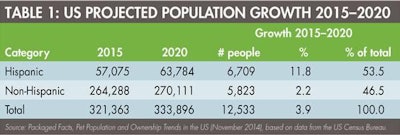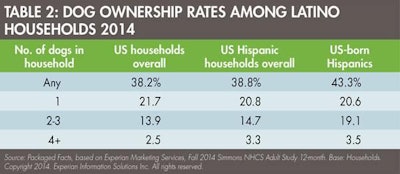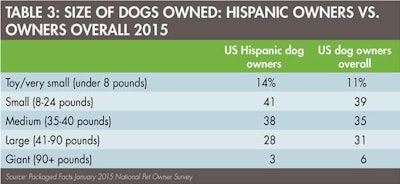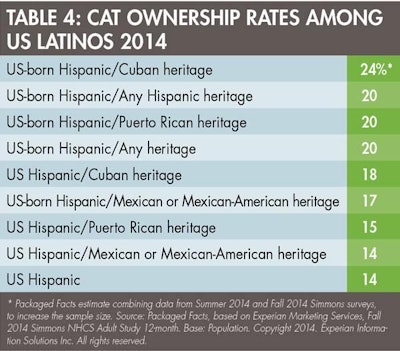
A slowdown in Hispanic immigration may result in a less robust growth rate in the Hispanic population in the near future. Even so, the Hispanic population is still projected to increase at a much faster rate than the rest of the American population—at 12% cumulatively between 2015 and 2020, compared with only 2% for non-Hispanics. As a result, Latinos will account for somewhat over half of the total growth in the US population during this period (see Table 1).

This is good news for the pet industry. Households with children have a higher-than-average likelihood of owning pets, and Latinos now account for 25% of all children under the age of five. Moreover, as US-born Latinos increase their numerical lead in the community in the wake of decreased immigration from south of the border (due to the US economic recession, among other factors), pet ownership rates are increasing among the Latino population.
That’s because the more acculturated Latinos become, the more likely they are to own dogs or cats. In fact, Latinos now match US households overall in dog ownership rates, and US-born Hispanics significantly beat the national average in dog ownership rates, at 43% versus 38% (see Table 2).

This dog ownership pattern is not only cultural but economic. US-born or acculturated Latinos are more likely to have the household income to afford the expenses of feeding dogs and keeping them healthy. Research compiled in 2014 by Burbank, California-based Santiago Solutions Group (SSG) confirms the importance of higher-income Latinos to the pet industry, indicating that dog ownership by “Latino Upscales” (defined as those with a household income between US$50,000 and US$100,000) is increasing at five times the rate of the Upscale market as a whole. Dog owners remain predominantly non-Hispanic white, but growth in the dog owner population is coming mostly from Latinos and other multicultural communities.
There are, of course, distinctive traits and important nuances among the over 5 million Latino households with dogs. Latinos of Mexican heritage, and correspondingly Latinos in the Southwest geographic region, are more likely to have dogs. Latinos overall, and especially those who are US-born, are more likely to have several dogs. In addition, Packaged Facts pet owner survey data show that Latino dog owners are somewhat more likely to have a toy-, small- or medium-size dog (at 14% vs. 11%, for toy/very small dogs), and somewhat less likely to own a large- or giant-size dog (see Table 3).

Cats are a different story (see Table 4). Compared with 26% of US households overall, only 15% of Hispanic households own cats, though the rate improves to 19% among US-born Hispanics. Flipping the pattern for dog ownership, moreover, Hispanics are much less likely than average to have four or more cats.

In addition, Hispanics of Cuban heritage—rather than those of Mexican heritage, in the case with dog ownership—are the prime cat fanciers. Cat ownership rates edge up to 18% among Hispanics of Cuban heritage, and notch up further to approximately 24% among US-born Cuban Americans, a population segment of oft-remarked prosperity compared with other Hispanics and with non-Hispanic whites overall. Such cultural, economic and geographic differences in dog and cat ownership within the Latino community rank among the key factors framing growth and entrepreneurial opportunities in the US pet food industry.


















